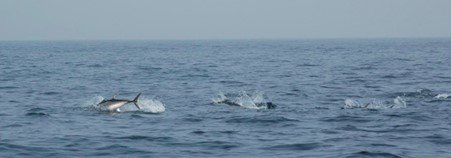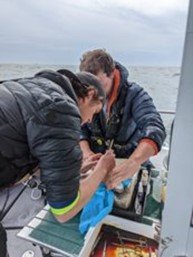
Fish INTEL: August 2022 update
Our Fish INTEL team came together for a meeting in Plymouth – with fine weather, exciting scientific developments, and discussing the emerging management possibilities with this new information, it was a successful and enjoyable few days.

The project team in Plymouth
Crawfish staying put
Towards the end of last year and earlier this year, we tagged 36 crawfish in the waters of the Isles of Scillies. So far, we’ve picked up over 240,000 recordings at our 1km square receiver network, located near to the east of St Martin’s.
The crawfish seem to be largely staying near to where they were released after being tagged, with 14 of them spending more than half of their time very close to where they were dropped off.
The tagging of French crawfish is due to start in September in Mer D’Iroise, over similarly closely-spaced listening networks.

St Martins Island (Isles of Scilly) and the estimated positions of a single tagged crawfish (red dots) around the 12 acoustic arrays (black dots). This shows they tend to have a ‘core area’ around which they are most active.
Bass move when it rains, but come back
Five weeks after most of the tagging took place, a storm event (with heavy rainfall) caused almost all bass to leave South Devon estuaries. They moved offshore and were sometimes recorded around shipwrecks and at other offshore listening devices, but many came back to the estuaries where they had been tagged once the storm had passed.
We believe this information is significant for management, as it suggests estuaries are the preferred habitat for the fish. Deeper shipwrecks in the Channel appear to be ‘passing areas’ rather than leading to ‘residency’ or permanent settling.
One or two bass have travelled large distances from the east, with one coming from as far as Belgian waters, where it was tagged by our partners at the LifeWatch Network. These bass have been recorded in offshore reef and wreck sites south of Devon.
Some UK estuarine-tagged fish moved west as well.

Bass moving from estuaries to deeper waters - even passing through a network of receivers designed for listening out for bluefin tuna!
Pollack in France
56 fish have now been successfully tagged near Ushant, France, and 34 acoustic listening devices have been installed both inside and outside windfarm locations in Brittany to listen out for pollack and bass. Discussions about the best locations of listening devices are continuing between our colleagues at the Fisheries Committees of Finisterre (West Brittany) and Normandy.
Our IFREMER colleagues (French government fisheries scientists based in Brest) in France have been accompanied by local and national politicians, increasing the profile of the project.

Acoustic arrays installed in Brittany waters to listen out for bass and pollack
Bluefin tuna
Our partners at the University of Exeter believe fish move great distances immediately after tagging. Indeed, three or four tunas were recorded at Isles of Scillies arrays, west of where they were originally tagged and released at Falmouth Bay – which is a straight-line distance of some 100km. Some have definitely crossed the channel as well.

Most fish have been recorded near to the locations they were originally tagged in and released. They were widely recorded around the acoustic listening devices. ABT sightings = Atlantic Bluefin Tuna sighting from recreational angling craft. Acoustic deployment is where fish were tagged and released.
The wondrous sea bream
Thinking about ecosystem-based management
Our partners at the University of Brest have been pulling together data on stakeholder use of the seas in French pilot sites. We’ve researched existing pilot site regulations, and how they directly or indirectly protect our target species.
The Isles of Scilly IFCA, who are partners in the project, have collaborated with Plymouth University in the past using ecosystem services mapping to support effective fisheries regulation, and we’re hoping to replicate some of these measures for the habitats that Fish INTEL species use, and where we can identify critical habitat.
We may need new areas to protect fish and shellfish. The more resident species are to an area, the more confident we can be in protecting them in that habitat, and the more likely we are to be protecting a part of the population.
Findings from movements of crawfish and seabass are already leading towards this thinking in our partners, and we’re expecting similar measures to be needed for pollack that are currently being heavily targeted in French waters.
Communicating updates
Fish INTEL is led by the University of Plymouth and funded by the Interreg Channel and European Regional Development Fund. Acoustic tagging in Sussex is supported by FISH INTEL, Sussex Wildlife Trust, Pebble Trust, Sussex IFCA, Natural England and RS Aqua.





